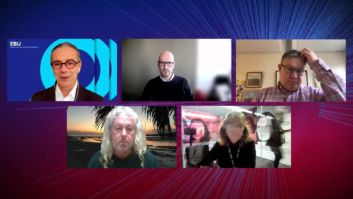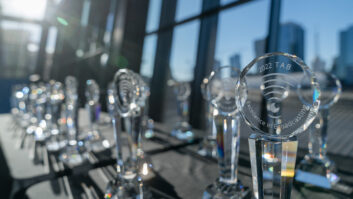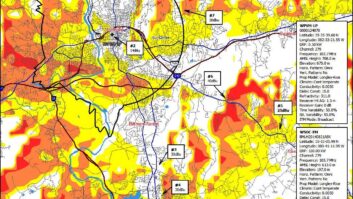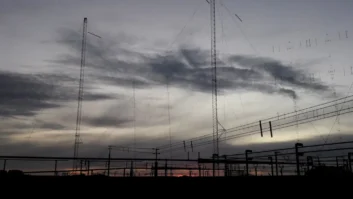Digital Radio Update – April 2, 2008
Apr 2, 2008 1:40 PM, By Mark Krieger, CBT
Index
- BBC’s Obreja to Chair DRM
- Worldspace Wins Terrestrial Repeater Approval from Switzerland
- HD Alliance Recalibrates Ad Campaign
- IBOC by State: Two for one
- As DOJ Nods, FCC Now at Odds on Sirius/XM Merger
- HD Radio at the NAB Show
- The New Language of Digital Radio
- APT, Enco Launch HD Radio-related Products at NAB 2008
NEWS
BBC’s Obreja to Chair DRM
Digital Radio Mondiale (DRM) has announced the unanimous election of Ruxandra Obreja, controller of business development for the BBC World Service, as chair of both the DRM Consortium and DRM Association. Obreja will replace outgoing chair Peter Senger, who now retires as DRM chair and member broadcaster Deutsche Welle’s director for the consortium.
The move came at the DRM steering committee’s biennial election, held at Deutsche Welle’s offices in Bonn, Germany, where Senger was recently honored for his contributions to the development of the DRM standard.
The DRM consortium also elected Jochen Huber of Transradio Sender Systeme Berlin, and Giuseppe Allamano of RAI Way as vice-chairs, while Alexander Zink of Fraunhofer IIS was elected as treasurer and vice chairman of the DRM Association.
Reflecting the leadership change, DRM’s Project Office has been slated for relocation to BBC facilities in London.
Worldspace Wins Terrestrial Repeater Approval from Switzerland
Worldspace Satellite Radio has received approval from Switzerland’s Office Federal de la Communication (OFCOM) to operate terrestrial repeaters designed to work in tandem with its satellite network to provide Swiss consumers with a subscription-based satellite radio service.
According to a company press release, the proposed terrestrial repeater network will use L-band spectrum between 1479.5 and 1492MHz, currently allocated for satellite radio service throughout Europe, the Middle East and Africa. Specific authorization for its satellite/terrestrial hybrid radio service has already been granted in Italy, Bahrain and United Arab Emirates (UAE).
Worldspace projects a service rollout on a country-by-country basis beginning with Italy, where aftermarket radios designed by Delphi are expected to be available to consumers in early 2009. The Company says it also expects to secure licenses in four other major European markets later this year.
BIZ
HD Alliance Recalibrates Ad Campaign
The HD Digital Radio Alliance is humming a new tune as it embarks on the latest leg of its ongoing on-air promotion of HD Radio this spring. The industry group is heralding the recent change in a press release that introduces the new tagline: HD Radio – It’s Time to Upgrade. The new phrase is an across-the-board shift in focus that encompasses new messaging, logos and radio ads.
Asserting that consumer awareness of HD Radio technology has assumed unprecedented levels, Alliance President and CEO Peter Ferrara says the change is a direct result of the group’s $500 million (to date) promotional campaign. Other support for the group’s claims comes from citation of a study by Critical Mass media pegging public awareness at 77 percent, as well as a separate study by JD Powers suggesting that 31 percent of potential auto buyers want HD Radio included in their next car.
“Clearly, our tagline and theme of ‘HD Radio – Discover It!’ worked extremely well,” notes Diane Warren, executive VP of the Alliance.
The new initiative also marks the launch of an expanded online marketing resource suite for broadcasters at the Alliance’s website www.hdradio.com, part of an industry focused promotional thrust that included an HD Radio Idea Summit for broadcasters and industry executives held earlier this month in Orlando, FL.
IBOC ACROSS AMERICA
IBOC by State: Two for one
Ibiquity has a list of stations with licensed HD Radio technology and notes those on the air now. IBOC by state looks at various states and lists the stations making the transition. This time we picked the two states with the fewest HD Radio stations. There is one station in North Dakota and two stations in Vermont broadcasting HD Radio signals.
MarketStationHD1 FormatHD2 FormatOwner North Dakota DickinsonKDIX-AM 1230AC/Oldes-Starrdak Vermont Montpelier-Barre-St JohnsburyWVPA-FM 88.5 Classical/News/Info Classical Vermont Public Radio BenningtonWBTN-FM 94.3 Classical/News/Info Classical Vermont Public Radio
EYE ON IBOC
As DOJ Nods, FCC Now at Odds on Sirius/XM Merger
With last week’s formal announcement by the Department of Justice that the agency will not contest a pending XM/Siruis merger, the FCC finds itself in the difficult position of now having to deliver a prompt decision, either with an outright approval, denial or — as most inside observers are betting — a lengthy list of stipulations.
Meanwhile, the announcement has brought howls of protest from NAB and consumer groups, as well as from a number of federal/state legislators that took pointed exception to DOJ’s claim that no significant reduction in competition would result from the merger.
Three general premises were outlined by the agency as it defended its decision:
- The merger will not significantly reduce competition between the two services, since the development of cross-platform receivers is currently impractical
- Competitive technologies, such as MP3 audio, wireless Internet, cellular multimedia distribution and HD Radio currently present a sufficient number of consumer options for audio content so as to constrain pricing on satellite radio subscriptions.
- Under pre-merger conditions, restrained competition between both providers was already in place, due to minimal duplication in content and exclusive receiver deals with carmakers.
While critics charge that the first premise is temporal at best, the DOJ’s move sets the stage for what is likely to become an acrobatic performance by a Commission clearly at odds with it own rationale in establishing the SDARS service and precedent set when it nixed a similar merger by DBS TV firms Dish and Directv in 2002. But even though FCC Chairman Kevin Martin recently referred to the deal as facing high hurdles, his agency has demonstrated a historically strong track record of moving in synch with DOJ on media consolidation cases.
In this deal, the old adage that the devil is in the details seems particularly appropriate. Just consider the many recommendations the Commission has heard thus far:
- Requiring a la carte pricing for both service providers
Knowing that Chairman Martin has long favored a pick and pay approach in the cable world, Sirius voluntarily proposed such an arrangement as an inducement for merger approval last summer. According to a Sirius press release, the proposed plan would give consumers the ability to choose from an array of different packages and price points, ranging from $6.99 to $16.99. A la carte programming would be available beginning within one year following the merger, and other programming options within six months following the merger. - Requiring the merged entity to offer a lease for access to 20 percent of its total channel capacity to Georgetown Partners
The minority-owned private equity investment group is headed by Chester Davenport, said to be a longtime ally of the Rev. Jesse Jackson and his Rainbow PUSH coalition. Reports indicate that Georgetown Partners asserts that its inclusion would ensure minority voices an adequate voice via satellite radio services. Georgetown has reportedly held dozens of meetings with the FCC regarding its proposal. A similar view was echoed by comments filed on behalf of radio giant Clear Channel Communications, which petitioned for a viable competitive alternative, to be ceded at least 50 percent of satellite capacity to a third party with complete control of programming. - Explicitly forbidding the newly merged firm from offering any localized content or services
Propelled largely by the NAB, supporters of terrestrial radio have asked the Commission to include stringent new rules barring a merged satellite radio provider from providing locally targeted content, including advertising, regardless of the technology involved. Broadcasters are also demanding that content on the merged systems become subject to broadcast indecency and obscenity rules. - Eliminating exclusive OEM satellite receiver deals with carmakers and requiring inclusion of HD Radio receivers in vehicles that include satellite receivers
This proposal to level the playing field for emerging digital radio technologies by requiring multi-mode functionality in factory installed radios was originally tendered by Ibiquity with the support of the NAB.
What tortured formula the FCC will eventually apply in an attempt to resolve this protracted and politically charged issue remains unclear, as Commission staffers remain close-lipped about internal deliberations. Yet in the midst of all this uncertainty, the only guaranteed result of the Commission’s forthcoming decision is this: XM and Sirius’ satellites are likely to have plenty of company in orbit.
HD Radio at the NAB Show
Several sessions in the Broadcast Engineering Conference at the NAB Show involved digital radio and particularly HD Radio. Others still touch on subjects that relate to digital delivery and the evolution of electronics media. Make note of these sessions on HD Radio. Be sure to check the on-site guides for schedule updates.
TimeSession TitlePresenterLocation April 13 9:30 a.m. – 10 a.m.Conditional Access: The Next Stage in HD Radio EvolutionTom Rucktenwald, Director, Data Applications Sales, NDSS226/227 10 a.m. – 10:30 a.m.Managing Radio Metadata for Multiplatform Digital DistributionDaniel Mansergh, Director of Engineering, KQED Public RadioS226/227 10:30 a.m. – 11 a.m.The Future of Radio in a Changing WorldDave Wilson, Director, Technology and Standards, Consumer Electronics AssociationS226/227 1:30 p.m. – 2 p.m.HD Audio Quality and NetcastingGreg Ogonowski, VP Product Development, Orban/CRLS226/227 3 p.m. – 3:30 p.m.A New Approach to Peak-to-Average-Power Reduction for FM IBOC TransmissionPhilipp Schmid, Research Engineer, NautelS226/227 4 p.m. – 4:30 p.m.An Improved Coverage Prediction Method for HD RadioJohn Kean, Senior Technologist, NPR LabsS226/227 April 14 1 p.m. – 1:30 p.m.The HD Radio STL: Issues, Options and TechnologiesBob Band, Business Development Manager, Harris Broadcast CommunicationsS228 2 p.m. – 2:30 p.m. Robust HD Radio Exporter to Exgine ArchitectureTim Anderson, FM/Digital Radio Product Line Manager, HarrisS228 3 p.m. – 3:30 p.m.Bandwidth & Frequency Allocation Issues in International Digital Radio AM and FM broadcastingChuck Kelly, Director, International Sales, NautelS228 April 15 10:30 a.m. – 11 a.m.Data Services for Digital BroadcastingAlexander Zink, Fraunhofer IISS228 April 16 10 a.m. – 11 a.m.The Role of the Detector in Spectrum Analyzer Measurement of Hybrid Digital SignalsDavid Maxson, Managing Partner, Broadcast Signal LabS228 11 a.m. – 11:30 a.m.RF Signal Performance Measurements of Consumer FM Receivers and Coverage EffectsJohn Kean, Senior Technologist, NPR LabsS228 3:30 p.m. – 4 p.m.Implications of IBOC Injection Levels above -20dBGary Liebisch, Regional Sales Manager – Eastern U.S., NautelS228 4 p.m. – 4:30 p.m.FM IBOC Building Penetration Tests at Elevated Digital Subcarrier LevelsGlynn Walden, Sr VP Engineering, CBS RadioS228
HD RADIO TERMINOLOGY
The New Language of Digital Radio
parity: In a binary-coded data vector, a condition maintained with a parity bit so that the total number of 1s or 0s is always odd, or always even.
OFDM subcarrier: A discrete frequency domain signal within the IBOC-necessary sidebands that is phase or phase-and-amplitude modulated. The IBOC digital waveform consists of numerous subcarriers uniformly spaced. All subcarriers are modulated synchronously at the symbol rate.
OFDM symbol: Time domain pulse containing all the active subcarriers and conveying all the data in one row from the interleaver and system control data sequence matrices. The transmitted waveform is the concatenation of successive OFDM symbols.
PRODUCTS
APT, Enco Launch HD Radio-related Products at NAB 2008
APT and Enco will be among the many vendors ready to introduce broadcasters to new HD Radio solutions at NAB 2008, now just a little more than a week away at Las Vegas Convention Center.
APT will be premiering its Worldcast Horizon HD, a new duplex stereo codec that enables broadcasters to deliver FM and HD content from studio to transmitter site. With both a T1 and ethernet interface, broadcasters can utilize existing T1 links for the FM transport and send their HD content as a UDP stream embedded within the T1. As a fully duplex device, APT says that the Worldcast Horizon HD will also allow off-air monitoring or an independent channel to backhaul RPU feeds and satellite down-linked audio. An RS-232 port is available for PAD and contact closures for remote control.
Also looking to leverage NAB crowd exposure is Enco Systems, which is promising Itunes tagging functionality for HD Radio to be added to its DAD digital audio delivery system at no additional charge — a departure from the practice that other manufacturers have followed. Enco’s implementation will be delivered in an upcoming release of DAD to be supported in an upcoming release of Padapult, a multipurpose real-time data delivery engine.
The exhibitor halls at the NAB Show will open to convention goers on Monday, April 14.












